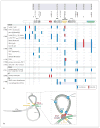Transcriptional control of the TNF gene
- PMID: 20173386
- PMCID: PMC4785889
- DOI: 10.1159/000289196
Transcriptional control of the TNF gene
Abstract
The cytokine TNF is a critical mediator of immune and inflammatory responses. The TNF gene is an immediate early gene, rapidly transcribed in a variety of cell types following exposure to a broad range of pathogens and signals of inflammation and stress. Regulation of TNF gene expression at the transcriptional level is cell type- and stimulus-specific, involving the recruitment of distinct sets of transcription factors to a compact and modular promoter region. In this review, we describe our current understanding of the mechanisms through which TNF transcription is specifically activated by a variety of extracellular stimuli in multiple cell types, including T cells, B cells, macrophages, mast cells, dendritic cells, and fibroblasts. We discuss the role of nuclear factor of activated T cells and other transcription factors and coactivators in enhanceosome formation, as well as the contradictory evidence for a role for nuclear factor kappaB as a classical activator of the TNF gene. We describe the impact of evolutionarily conserved cis-regulatory DNA motifs in the TNF locus upon TNF gene transcription, in contrast to the neutral effect of single nucleotide polymorphisms. We also assess the regulatory role of chromatin organization, epigenetic modifications, and long-range chromosomal interactions at the TNF locus.
Copyright (c) 2010 S. Karger AG, Basel.
Figures



Similar articles
-
Cell-type-specific regulation of the human tumor necrosis factor alpha gene in B cells and T cells by NFATp and ATF-2/JUN.Mol Cell Biol. 1996 Oct;16(10):5232-44. doi: 10.1128/MCB.16.10.5232. Mol Cell Biol. 1996. PMID: 8816436 Free PMC article.
-
Regulation of tumor necrosis factor alpha gene expression by mycobacteria involves the assembly of a unique enhanceosome dependent on the coactivator proteins CBP/p300.Mol Cell Biol. 2003 Jan;23(2):526-33. doi: 10.1128/MCB.23.2.526-533.2003. Mol Cell Biol. 2003. PMID: 12509451 Free PMC article.
-
Nuclear factor-kappa B mediates TNF-alpha inhibitory effect on alpha 2(I) collagen (COL1A2) gene transcription in human dermal fibroblasts.J Immunol. 1999 Apr 1;162(7):4226-34. J Immunol. 1999. PMID: 10201951
-
Signal transduction by tumor necrosis factor and gene regulation of the inflammatory cytokine interleukin-6.Biochem Pharmacol. 2000 Oct 15;60(8):1185-95. doi: 10.1016/s0006-2952(00)00412-3. Biochem Pharmacol. 2000. PMID: 11007957 Review.
-
Keeping up NF-kappaB appearances: epigenetic control of immunity or inflammation-triggered epigenetics.Biochem Pharmacol. 2006 Oct 30;72(9):1114-31. doi: 10.1016/j.bcp.2006.07.012. Epub 2006 Aug 24. Biochem Pharmacol. 2006. PMID: 16934762 Review.
Cited by
-
Both Neisseria gonorrhoeae and Neisseria sicca Induce Cytokine Secretion by Infected Human Cells, but Only Neisseria gonorrhoeae Upregulates the Expression of Long Non-Coding RNAs.Pathogens. 2022 Mar 24;11(4):394. doi: 10.3390/pathogens11040394. Pathogens. 2022. PMID: 35456069 Free PMC article.
-
Viral enhancer mimicry of host innate-immune promoters.PLoS Pathog. 2014 Feb 6;10(2):e1003804. doi: 10.1371/journal.ppat.1003804. eCollection 2014 Feb. PLoS Pathog. 2014. PMID: 24516378 Free PMC article. Review. No abstract available.
-
Periodontitis-related salivary microbiota aggravates Alzheimer's disease via gut-brain axis crosstalk.Gut Microbes. 2022 Jan-Dec;14(1):2126272. doi: 10.1080/19490976.2022.2126272. Gut Microbes. 2022. PMID: 36175166 Free PMC article.
-
Epigenetic priming sensitizes gastric cancer cells to irinotecan and cisplatin by restoring multiple pathways.Gastric Cancer. 2020 Jan;23(1):105-115. doi: 10.1007/s10120-019-01010-1. Epub 2019 Sep 25. Gastric Cancer. 2020. PMID: 31555951
-
The TNF-α/TNFR2 Pathway: Targeting a Brake to Release the Anti-tumor Immune Response.Front Cell Dev Biol. 2021 Oct 12;9:725473. doi: 10.3389/fcell.2021.725473. eCollection 2021. Front Cell Dev Biol. 2021. PMID: 34712661 Free PMC article. Review.
References
-
- Aggarwal BB, Samanta A, Feldmann M. TNFα. In: Oppenheim J, Feldmann M, editors. Cytokine Reference. Orlando: Academic Press; 2000. pp. 413–434.
-
- Grivennikov SI, Kuprash DV, Liu ZG, Nedospasov SA. Intracellular signals and events activated by cytokines of the tumor necrosis factor superfamily: from simple paradigms to complex mechanisms. Int Rev Cytol. 2006;252:129–161. - PubMed
-
- Beutler B, Cerami A. Cachectin and tumor necrosis factor as two sides of the same biological coin. Nature. 1986;320:584. - PubMed
-
- Steffen M, Ottmann OG, Moore MA. Simultaneous production of tumor necrosis factor-α and lymphotoxin by normal T cells after induction with IL-2 and anti-T3. J Immunol. 1988;140:2621–2624. - PubMed
Publication types
MeSH terms
Substances
Grants and funding
LinkOut - more resources
Full Text Sources

